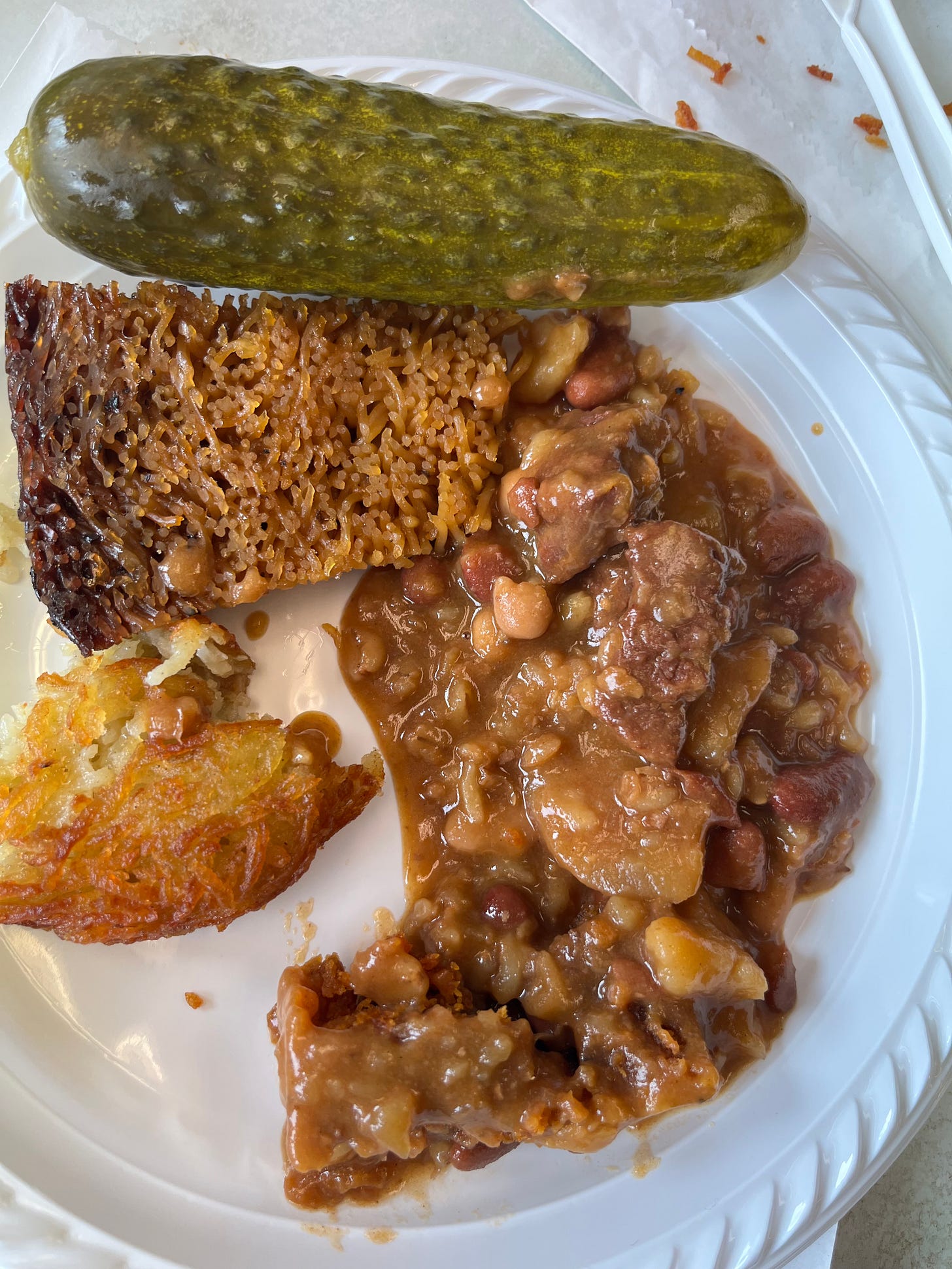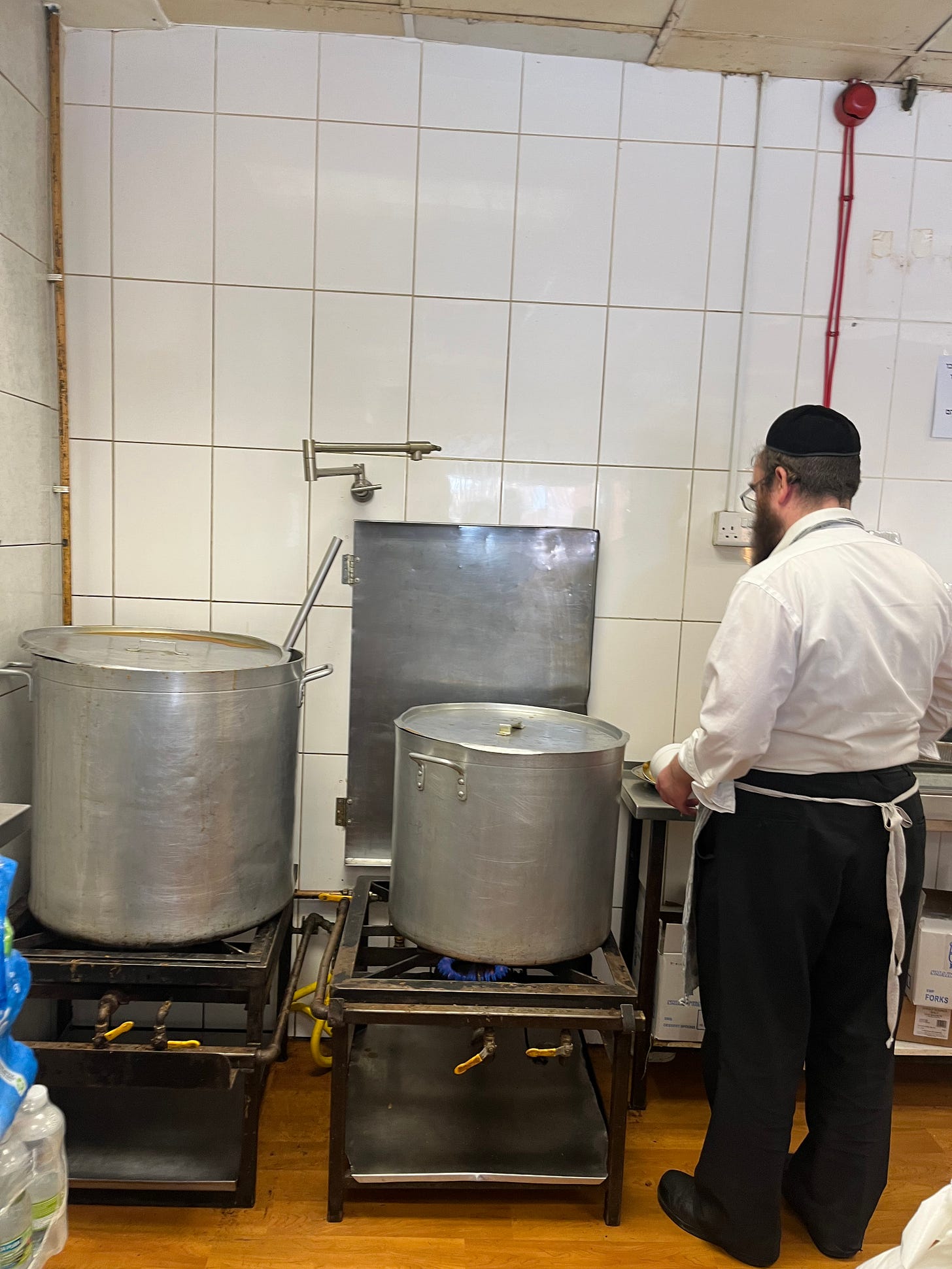British Jewish Food Week
A Vittles Project: Ten essays and guides on British Jewish food, edited by Molly Pepper Steemson
Good afternoon and welcome to Vittles British Jewish Food Week, our first full-scale food project.
The following package is made up of ten essays and guides that explore what Jewish food means in this country today: from salt beef bars to ‘Middle Eastern restaurants’, from Stamford Hill to Prestwich, from the ‘visible’ to the ‘so ubiquitous we almost miss it’. All ten articles can be found below and on our website, and can be read in your own time, although we will release some as newsletters individually this week.
Most of the essays are unpaywalled, but to read the whole project please subscribe for £5/month or £45/year, which gives you access to our whole back catalogue and ensures all writers are paid fairly. Thank you so much for your support!
A note from the editor
Upon starting this project many months ago, I watched and rewatched Georgia Brown’s 1968 episode of One Pair of Eyes for the BBC. At the start of the programme, she stands outside her old synagogue, stares straight into the camera and says – screen full of face – “I’m a Jew.”
I’m a Jew, too. My mother was Jewish, and like others before her, she got married and moved to northwest London, where I grew up. Georgia Brown came from the generation before my mother’s and grew up in the East End. In 1968 she was visiting to see how it had changed and see what, of Jewish culture, was left. She reflects on the fading East End Jewry with gentle understanding, without reticence or remorse:
“From the London Hospital to the Aldgate Pump — that’s my mile, and it means chicken soup and warmth and acceptance and an enormous ability to change very rapidly.”
My mile is on the other side of the city, stretching from the Kilburn High Road to Hampstead Heath. Growing up, my friends’ miles were similar: St John’s Wood High Street to Temple Fortune, Cricklewood Broadway to Highgate Cemetery. There are Jewish miles all over this country, from Broughton Park to Prestwich in Greater Manchester, to Canvey Island in Essex. They all mean chicken soup, warmth and acceptance. These British miles, however, unlike the American ones, are often less visible. We do not have the same recognisably Jewish culture in our restaurants (Katz’s, Langer’s, Russ & Daughters et al) or literature (Roth). It doesn’t really exist on our radios (Stern) or televisions (Seinfeld) in the same way, either. British Jewish food - like British Jewish culture - exists, it’s just not as visible.
We began this project with the idea we might pinpoint what Jewish British Food Culture is, but soon realised the search for a precise answer was futile. We’ve ended up drawing a sprawling map of it. Some parts of it are broadly sketched in, others are painted in granular detail. Looking back, I can’t think of another way we could’ve tackled it.
Our project, perhaps necessarily, concentrates on the twin hubs of British Jewry: north London and north Manchester. In our lead essay, Dan Hancox has written a potted history of Jewish Food in Britain and its influence on how we eat, from Bradford to the West End. In ‘The Shop’, Laura Goodman has penned an elegy to the Edgware institution B&K Salt Beef Bar, and the unlikely relationship between north London’s Cypriot and Jewish communities. In ‘Keeping Kosher?’ Martin Francisco Saps looks at the fault lines between koshering certifications, and how this determines the unique food culture of the country’s neighbourhood with the largest concentration of observant Jews, Stamford Hill. Josh Dell interrogates the world of MiddleEastMediLevantia, the largest contribution by Jews to the contemporary culinary trends in the UK, and tracks how the notion of the British Jewish restaurant is changing. From the archives, we have opened up Joel Hart’s essay on the Syrian restaurants of Manchester, and their reliance on a predominantly Jewish clientele remembering the food of their past, while Atar Hadari takes a tour of north Manchester, tracing the changing tastes of Prestwich’s Orthodox community who look towards the future, away from cholent and towards kosher sushi.
For those who want to know where to eat well, we have compiled extensive restaurant, deli and takeaway guides for London and Manchester, while Adrienne Katz-Kennedy has spent months eating to give us a deep dive on London’s Jewish bakeries via the smallest and often-overlooked Jewish baked good: the rugelach. Finally, the project’s centrepiece is Friday Night Dinners, a compilation of tales of Jewish domestic traditions from around the country.
As Claudia Roden says in the introduction of The Book of Jewish Food, “Jewish food tells the story of an uprooted, migrating people and their vanished worlds.” Some of the worlds touched on in the project have truly vanished; many are simply hidden. The Jewish mile, in Britain, continues to move and multiply. Some think it has assimilated or diluted; to others that is the basis of its survival. It has, like those who walk along it, an enormous ability to change very rapidly. Molly Pepper Steemson
What is British Jewish food, really?, by Dan Hancox
The story of Jewish food in Britain
The Shop, by Laura Goodman
How one Cypriot family preserved the London Jewish deli
“I often hear people referring to the man behind the counter - no matter who it is - as ‘one of the brothers’, which is not always accurate but gives the shop a sort of agelessness, as though it’s still founder Bambos Georgiou doing the business, not his sons and grandsons. It’s also small: when you eat in, the person behind the counter is always within earshot. Bambos’s son, Michael Georgiou, can tell you an astonishing story about two Auschwitz survivors spotting each other from opposite ends of the counter and screaming – screaming – with recognition after fifty years. He watched it all from his station, by the beef.”
Keeping Kosher?, by Martin Francisco Saps
A battle over food, tradition, and autonomy in Stamford Hill
“The overwhelming majority of London’s religious Jews, including the Modern Orthodox, are content to follow the London Beth Din (LBD) or any of the ‘Big Five’ kosher organisations. Many Sephardi Jews, although outside of LBD’s tradition, will follow their hechsher (the kosher stamp). For more traditional Sephardic Jews (and 10% of British Jews identify as such) there’s the Sephardi Kashrut Authority, which enforces the kosher standards of Jews originating from that tradition, while for Jews who are stricter – namely the ‘Litvish’ sect – there’s the Kosher Federation (KF), which prides itself on ‘providing the highest standards of kosher food certification’. This means most people’s choice of kosher certification comes down to, ‘These are my people, this is my community, I’d rather have the one that I know’, as Yanky Fischer, owner of Stamford Hill’s largest sit-down restaurant Asado, explains. Like with everything, Stamford Hill plays by its own rules: the rules of HaShem, as interpreted by the Kedassia.”
The Rise of MiddleEastMediLevantia, by Josh Dell
What is the British Jewish restaurant now?
“The major Jewish culinary contribution of the twentieth century was Ashkenazi cuisine – easily identifiable as European and openly identified as Jewish. The major Jewish culinary contribution of the twenty-first century is a set of restaurants, newspaper columns and cookbooks whose strength is a lack of identity (beyond basic Middle Eastern geographic markers). Where the Nosh Bar and Bloom’s traded on their Jewish identity, many of these new restaurants use other descriptors: Levantine, Middle Eastern, Mediterranean, as if they come from an ambiguous land called MiddleEastMediLevantia. Even more notably, they nearly all avoid mentioning the place that serves as the home of their founders or the inspiration for their food: Israel.”
Friday Night Dinners
Life, death, and chicken soup
“The real food – the food of foods – is the challah. The reason Jews place a pair of challahs on the table is based on the story in Exodus that says two portions of manna came down to feed the children of Israel as they wandered the wilderness on the Sabbath. Given the bread of affliction those kids set out with, that surplus must have felt like an amazing bounty. And I can’t be the only one, surely, to associate the two challahs with the infant’s early dependence on the mother’s bountiful breasts (unless I am the only one?). For there really is something about challah. A good, fresh challah tastes like manna from heaven, even though somebody’s labour – traditionally the mother’s – went into making it. In challah we taste how fortunate we are to be settled. But in challah we also remember how precarious and temporary our situation is; how near we always are to hunger, begging, homelessness. Inside a Jewish joke, we learn from Freud, you’re liable to find both enormous pleasure and a barely repressed history of trauma. You could say the same for a Jewish meal, too.” Devorah Baum
Where Has All the Tchulent Gone? by Atar Hadari
The changing tastes of orthodox Jewish Manchester
From Aleppo to Manchester, by Joel Hart
Syrian restaurants in Manchester and their Jewish clientele
The London Rugelach Index, by Adrienne Katz-Kennedy
A guide to London's Jewish bakeries via its smallest offering
A guide to Jewish food in Manchester
From the country’s best cholent and kugel to amba coronation chicken
“Manchester’s best Jewish food has always been found at Friday night dinners, Shabbat lunches and catered events – prepared by home cooks, both Ashkenazi and Sephardi. For many Jewish Mancunians, their food is either understood through what you eat in your own home and the homes of others, or through well-kept communal secrets. Most have heard of the Hyman family, who operated butchers and delis in the past, but now focus on producing very good smoked salmon at The Manchester Smokehouse. And most know Estelle Shiers, a cake producer who doesn’t exist on the internet, and yet whose sponge and multi-coloured icing combo has appeared at all major birthdays. My own tastebuds didn’t learn what Jewish food is by visiting the city’s kosher restaurants, but by eating Rochel Yaffe’s challah, Sara Senior’s tahdig, Rene Hodari’s kibbeh and my grandmother’s chicken soup.” Joel Hart
A guide to Jewish food in London
Fifty places to eat: delis, salt beef bars, restaurants, beigel/bagel shops and more
“The truth is that trying to evaluate either on quality misses the point. They are late-night luscious messiness, food made divine in vast quantities, made to be eaten through argument and gesticulation: they are the taste of this 24/7 agora of working-class Jewish immigrants in the late nineteenth and early twentieth centuries…. Avoid the white shop because two heirs to a German mafia dynasty, William and Kate, once went there for a photo op rolling beigels.” Barnaby Raine
Credits
Thank you to Dan Hancox, Laura Goodman, Martin Francisco Saps, Josh Dell, Adrienne Katz Kennedy, Atar Hadari, Joel Hart, Devorah Baum, Jonathan Beckman, Miles Coleman, Samson Hart, Eli Lee, Charlotte Mendelson, Tomé Morrissy-Swan, Leeor Ohayon, Rachel Shabi, Tabitha Steemson, Liz Tray, Aaron Vallance, Eva Wiseman, Montague Ashley-Craig, Ari Steinberger, Stewart Tray, Andrew Humphrey, Ben Barsky, Barclay Bram, Barnaby Raine, Feroz Gajia, Jesse Bernard and Tom Victor.
Vittles British Jewish Food Week is edited by Molly Pepper Steemson, with additional editing from Jonathan Nunn and Adam Coghlan, and subediting by Sophie Whitehead and Liz Tray.
All illustrations are by Georgia Turner, a freelance illustrator and neuroscience PhD student from London. Photography by Michaël Protin.














This is WONDERFUL
This is amazing, such a lot of reading and I love it. Thank you